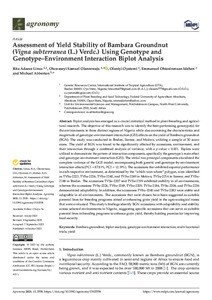| dc.contributor.author | Linus, R.A. |
| dc.contributor.author | Olanrewaju, O.S. |
| dc.contributor.author | Oyatomi, O. |
| dc.contributor.author | Idehen, E.O. |
| dc.contributor.author | Abberton, M. |
| dc.date.accessioned | 2023-10-30T08:10:06Z |
| dc.date.available | 2023-10-30T08:10:06Z |
| dc.date.issued | 2023-10-04 |
| dc.identifier.citation | Linus, R.A., Olanrewaju, O.S., Oyatomi, O., Idehen, E.O. & Abberton, M. (2023). Assessment of yield stability of bambara groundnut (Vigna subterranea (L.) Verdc.) using genotype and genotype-environment interaction biplot analysis. Agronomy, 13(10): 2558, 1-15. |
| dc.identifier.issn | 2073-4395 |
| dc.identifier.uri | https://hdl.handle.net/20.500.12478/8316 |
| dc.description.abstract | Biplot analysis has emerged as a crucial statistical method in plant breeding and agricultural research. The objective of this research was to identify the best-performing genotype(s) for the environments in three distinct regions of Nigeria while also examining the characteristics and magnitude of genotype–environment interaction (GEI) effects on the yield of Bambara groundnut (BGN). The study was conducted in Ibadan, Ikenne, and Mokwa, utilizing a sample of 30 accessions. The yield of BGN was found to be significantly affected by accessions, environment, and their interaction through a combined analysis of variance, with a p-value < 0.001. Biplots were utilized to demonstrate the pattern of interaction components, specifically the genotype’s main effect and genotype–environment interaction (GEI). The initial two principal components elucidated the complete variance of the GGE model, encompassing both genetic and genotype-by-environment interaction effects (PC1 = 87.81%, PC2 = 12.19%). The accessions that exhibited superior performance in each respective environment, as determined by the “which-won-where” polygon, were identified as TVSu-2223, TVSu-2236, TVSu-2240, and TVSu-2249 in Mokwa; TVSu-2214 in Ikenne; and TVSu-2188 in Ibadan. The accessions TVSu-2207 and TVSu-2199 exhibited stability in all environments, whereas the accessions TVSu-2226, TVSu-2249, TVSu-2209, TVSu-2184, TVSu-2204, and TVSu-2236 demonstrated adaptability. In addition, the accessions TVSu-2240 and TVSu-2283 were stable and adaptable in all environments. The accessions that were chosen have been suggested as suitable parental lines for breeding programs aimed at enhancing grain yield in the agro-ecological zones that were evaluated. This study’s findings identify BGN accessions with adaptability and stability across selected environments in Nigeria, suggesting specific accessions that can serve as suitable parental lines in breeding programs to enhance grain yield, thereby holding promise for improving food security. |
| dc.description.sponsorship | Global Crop Diversity Trust |
| dc.description.sponsorship | CGIAR |
| dc.format.extent | 1-15 |
| dc.language.iso | en |
| dc.subject | Bambara Groundnuts |
| dc.subject | Analysis |
| dc.subject | Genotype Environment Interaction |
| dc.subject | Yields |
| dc.title | Assessment of yield stability of bambara groundnut (Vigna subterranea (L.) Verdc.) using genotype and genotype-environment interaction biplot analysis |
| dc.type | Journal Article |
| cg.contributor.crp | Genebanks |
| cg.contributor.crp | Roots, Tubers and Bananas |
| cg.contributor.affiliation | Federal University of Agriculture Abeokuta |
| cg.contributor.affiliation | International Institute of Tropical Agriculture |
| cg.contributor.affiliation | North-West University, South Africa |
| cg.coverage.region | Africa |
| cg.coverage.region | West Africa |
| cg.coverage.country | Nigeria |
| cg.coverage.hub | Headquarters and Western Africa Hub |
| cg.researchtheme | Biotech and Plant Breeding |
| cg.identifier.bibtexciteid | LINUS:2023 |
| cg.isijournal | ISI Journal |
| cg.authorship.types | CGIAR and developing country institute |
| cg.iitasubject | Agronomy |
| cg.iitasubject | Food Security |
| cg.iitasubject | Genetic Improvement |
| cg.iitasubject | Grain Legumes |
| cg.iitasubject | Plant Breeding |
| cg.iitasubject | Plant Genetic Resources |
| cg.iitasubject | Plant Production |
| cg.journal | Agronomy |
| cg.notes | Open Access Article |
| cg.accessibilitystatus | Open Access |
| cg.reviewstatus | Peer Review |
| cg.usagerightslicense | Creative Commons Attribution 4.0 (CC BY 0.0) |
| cg.targetaudience | Scientists |
| cg.identifier.doi | https://doi.org/10.3390/agronomy13102558 |
| cg.iitaauthor.identifier | Oluwaseyi Olanrewaju: 0000-0002-1682-1060 |
| cg.iitaauthor.identifier | Olaniyi Oyatomi: 0000-0003-3094-374X |
| cg.iitaauthor.identifier | Michael Abberton: 0000-0003-2555-9591 |
| cg.futureupdate.required | No |
| cg.identifier.issue | 10: 2558 |
| cg.identifier.volume | 13 |
| cg.contributor.acknowledgements | The assistance rendered by the staff of the Genetic Resources Center, IITA, is greatly appreciated. |

